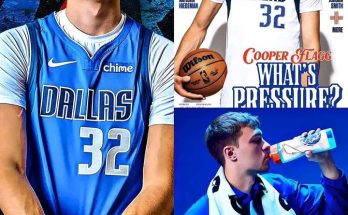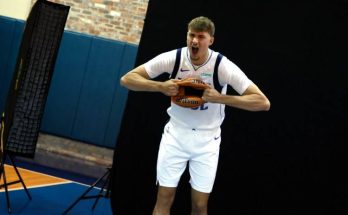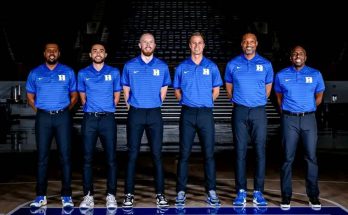Patrick Beverley has never been one to shy away from bold opinions, and his latest take has set the basketball world abuzz. The fiery guard recently declared that Paul George would have been better than Klay Thompson for the Golden State Warriors dynasty. Coming from a player known for his outspoken personality and deep respect for talent across the league, Beverley’s statement demands a closer look, not only for what it suggests about George’s talent but also for what it implies about the way we view the Warriors’ championship run. This comment forces fans, analysts, and even players themselves to rethink what might have been if one of the NBA’s most complete two-way stars had been part of the most successful modern dynasty in basketball.
To understand Beverley’s point, we must first revisit what made the Warriors so dominant in the first place. At their peak, Golden State had the perfect balance of talent, shooting, unselfishness, and defensive versatility. Stephen Curry redefined basketball with his limitless shooting range and gravity that warped defenses. Draymond Green anchored the defense while serving as a playmaking hub. And then there was Klay Thompson, perhaps the most ideal complementary star in modern basketball history. Thompson’s elite catch-and-shoot ability, defensive prowess, and low-maintenance playing style made him indispensable to the Warriors’ system. He didn’t need the ball in his hands, he didn’t need a high usage rate, and he could go off for 37 points in a quarter or 60 points on 11 dribbles. Thompson was built to thrive next to Curry, and his impact on the dynasty is undeniable.
But Beverley’s argument pushes us to consider: what if, instead of Thompson, the Warriors had Paul George? The idea isn’t entirely far-fetched. George, a multiple-time All-Star and perennial All-NBA talent, has long been regarded as one of the most skilled two-way wings in the league. At his best, George combines elite perimeter shooting with playmaking, slashing, and lockdown defense. Unlike Thompson, who primarily functions as an off-ball weapon, George can create his own shot, break down defenses, and serve as a primary or secondary playmaker. He’s taller, longer, and more versatile than Thompson, capable of guarding virtually every position on the floor. In Beverley’s eyes, this all-around package could have made the Warriors even more unstoppable than they already were.
The case for George starts with his offensive versatility. Thompson’s shooting is legendary, but George offers a more dynamic offensive skill set. George has career averages north of 20 points per game, with multiple seasons scoring 23 or more while handling primary scoring duties. His ability to score at all three levels — from deep, in the mid-range, and at the rim — would give the Warriors an added dimension. During their peak years, the Warriors often relied heavily on Curry’s creation, and while Thompson’s shooting opened up the floor, he wasn’t someone you could consistently give the ball to and expect him to create offense in isolation. George, on the other hand, thrives in those situations. Imagine a scenario where defenses trap Curry at half court, only to have George on the wing, capable of attacking off the dribble, pulling up from three, or facilitating for teammates. That kind of dynamic would have made the Warriors’ offense even scarier than it already was.
Defensively, Beverley’s point becomes even more compelling. Thompson, at his peak, was an elite perimeter defender who often took the assignment of guarding the opposing team’s best guard. He played a crucial role in containing stars like Kyrie Irving and James Harden in playoff series. However, George is on another level defensively. With his length, athleticism, and instincts, George is a perennial All-Defensive team player who can switch onto guards, wings, and even bigs. In an era defined by versatile wings like LeBron James, Kawhi Leonard, and Kevin Durant, George’s ability to match up across positions would have given Golden State even more defensive flexibility. Instead of relying on Draymond Green to cover for mismatches, the Warriors could have fielded two elite defensive stoppers in George and Green, with Curry roaming and Thompson’s role minimized. That defensive ceiling is enough to make one wonder whether Golden State might have gone from great to unbeatable.
Of course, there’s another side to this argument. Thompson wasn’t just a shooter and defender; he was the perfect complement to Curry. His willingness to move without the ball, to sacrifice touches, and to focus on spacing the floor cannot be overstated. Basketball history is filled with examples of great players who couldn’t coexist because they both needed the ball in their hands. Thompson was the opposite of that. He didn’t demand the spotlight, and his game fit seamlessly into the Warriors’ motion-heavy offense. George, as great as he is, has always been a higher-usage player who thrives with the ball in his hands. Would he have been willing to take a backseat to Curry the way Thompson did? Would he have been able to suppress his natural inclination to create and instead function as a secondary piece? That’s where Beverley’s claim meets resistance.
Another factor to consider is availability and durability. Thompson, before his devastating ACL and Achilles injuries, was remarkably consistent. He rarely missed games, showed up in the playoffs, and had some of his best performances on the biggest stages. George, on the other hand, has battled a history of injuries, from his catastrophic leg fracture in 2014 to recurring shoulder, knee, and hamstring issues throughout his career. The Warriors’ dynasty was built not only on talent but also on health and chemistry. Could George have provided the same level of stability that Thompson did? That’s far from certain.
Still, Beverley’s perspective isn’t simply about comparing skill sets. It’s also about imagining the peak version of George inserted into one of the most dangerous systems in basketball history. At his best, George has shown flashes of being a top-five player in the league. His 2018-19 season with the Oklahoma City Thunder, where he finished third in MVP voting, showcased just how dominant he could be as a two-way force. If that version of George were plugged into the Warriors’ dynasty years, Golden State may have had an even higher ceiling than they did with Thompson.
The conversation also opens up broader questions about how we evaluate players in the context of a system. Thompson will forever be remembered as a Warrior, and his legacy is tied to the team’s success. But if Thompson had played elsewhere without Curry to draw attention and Draymond to cover defensively, would his career have been viewed the same way? Conversely, George has spent much of his career as the focal point of his teams, carrying responsibilities that Thompson never had to bear. Is it possible that if George had the chance to play next to Curry, his efficiency and impact would have been magnified, making him look even better than he has at his peak?
There’s also the matter of chemistry. The Warriors’ dynasty wasn’t just about talent — it was about the harmony of roles. Curry was the superstar, Green was the emotional engine, and Thompson was the steady, unselfish co-star who did whatever was needed without complaint. George, as talented as he is, has sometimes struggled in those roles. His tenure with the Clippers has been marked by inconsistency and questions about leadership. Would that have meshed with the Warriors’ delicate ecosystem? It’s hard to say.
Ultimately, Beverley’s claim is less about tearing down Thompson and more about elevating George’s talent. Thompson was the perfect piece for Golden State, but George might have been the more talented player overall. It’s the classic debate between fit and skill. Thompson fit better, but George may have raised the team’s ceiling. And in Beverley’s eyes, that ceiling was worth considering.
The truth likely lies somewhere in the middle. The Warriors probably don’t become the dynasty they did without Thompson’s unique skill set and mentality. But it’s equally true that inserting a prime Paul George into that mix could have created an even scarier version of Golden State, one that might have won even more titles or dominated with fewer obstacles. Beverley, as always, thrives on stirring debate, and in this case, he’s succeeded. He’s forced fans to reimagine one of the greatest teams ever with a different star, and that’s a fascinating thought experiment.
Whether you agree or not, Beverley’s statement underscores just how special both players are. Thompson’s legacy is etched in stone, but George’s talent continues to spark conversations about what might have been if circumstances were different. In the end, it may not be about who was “better” but rather about how both players, in their own ways, represent two different paths to greatness — one through fit and sacrifice, the other through all-around brilliance. And as long as debates like these continue, basketball fans will never run out of what-ifs to explore.



